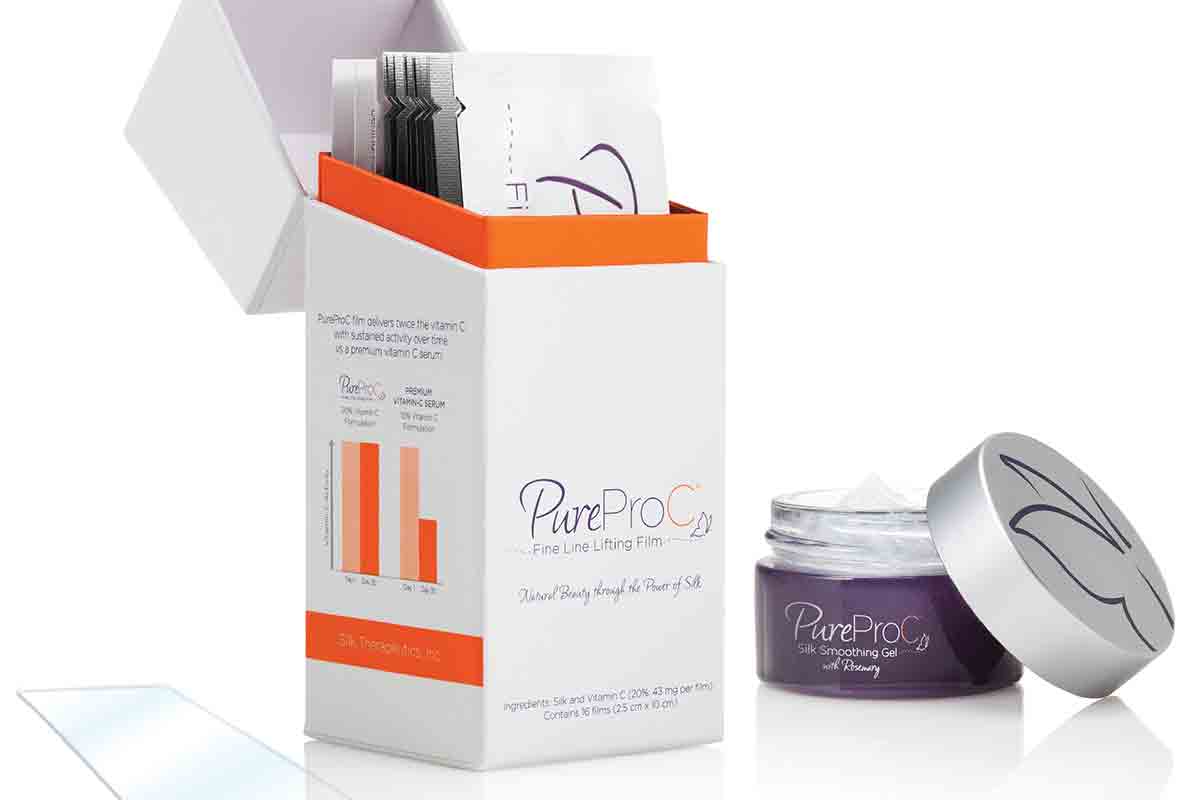Tufts Alum Create a Silk-Based Skin Care Line

Product image provided.
There’s always an au courant miracle beauty product that makes its way to store shelves and into lifestyle magazines by promising younger looking skin, smoothed out wrinkles, and disappearing fine lines. But, in the end, we shell out hundreds of dollars on something filled with chemicals that really doesn’t do diddly-squat.
That’s why Medford-based Silk Therapeutics, Inc., (ST) wants to introduce you to the world of silk, and how this Japanese import may just be the next big thing in skin care. Greg Altman, the company’s CEO, Rebecca Horan (COO), and David Kaplan, professor and chair of the Department of Biomedical Engineering at Tufts University, developed the company’s proprietary “pure silk technology platform,” which naturally delivers molecules to the skin. So, if you wanted to give the skin a high intensity dose of vitamin C—an antioxidant currently found in a number of skin care products, which has been clinically shown to increase skin vitality and diminish the appearance of fine lines, scars, and wrinkles—you could use this silk protein to get it there.
ST launched its first products in June, which is just the beginning for this new, anti-aging skin care line. The “PureProC Fine Line Lifting Film” and “PureProC Silk Smoothing Gel” utilize the power of pure silk protein to effectively deliver concentrated levels of vitamin C to the skin to reduce wrinkles and fine lines, Altman says.
“Until now, vitamin C has not been able to achieve its full potential as an anti-aging ingredient because it loses its free-radical fighting ability almost immediately when exposed to air, before it can be absorbed into the skin,” Altman says. “Our technology protects vitamin C in natural, pure silk protein, allowing it to completely absorb into the skin at its maximum strength to reduce fine lines and wrinkles and restore skin to a youthful, vibrant and refreshed tone.”
Silk, Altman says, is a biomaterial that could one day replace the chemical fillers and preservatives in cosmetics. The company’s skincare products are comprised of the fiber protein of the Bombyx mori silkworm, which is imported from Japan, and delivers molecules like vitamin C in their active form directly to the skin without the need for synthetic additives or the addition of harsh chemical preservatives. In fact, the only ingredients in the products are silk, water, and vitamin C.
“Our main goal for this brand is ‘beauty without consequence’ and to support the most vulnerable segments of our population,” Altman says. “It’s for the masses, but the real goal is to provide something that women undergoing chemotherapy can use, or that pregnant or breastfeeding women can use. For someone undergoing the rigors and trials of chemo, we want to be able to provide them a luxurious and safe skin care product to use. People have been really getting behind us about trying to do something based on science that brings silk and vitamin C to the skin without any additives.”
Altman is no stranger to silk-based technology. During his senior year at Tufts, he blew out his ACL playing football. Altman says that he then became interested in biomedical engineering. “I was interested in trying to bioengineer ligament with silk fibers,” Altman says. “We ended up patenting the technology and getting FDA approval for a biocompatible and biodegradable silk protein matrix. Basically it’s just silk fibers that we purify and can then be implanted into the human body to help reconstruct tissue. We developed it to also work for the knee and rotator cuff repair, but it turns out the same mechanics necessary to repair a rotator cuff are the same requirements that can also help in breast reconstruction after mastectomy. The same way we would repair a tendon in a shoulder we could use use the silk protein matrix to repair breast tissue.”
Altman and his team sold that technology to Allergan in 2010, which is currently using the technology for breast reconstruction and soft tissue repair. Altman stayed on at Allergan for a number of years after selling his invention, and that’s what got him interested in skin care.
The PureProC Silk Smoothing Gel contains only four ingredients: pure silk to smooth and protect the skin; vitamin C; water; and either lemongrass or rosemary, which supposedly provides additional natural antioxidant and anti-inflammatory properties to promote cellular rejuvenation and improve skin tone. Altman says that the Gel effectively delivers a boost of proven antioxidants throughout the day to diminish fine lines and wrinkles, reduce redness and puffiness, and tones, protects, and smoothes skin texture.
The PureProC Fine Line Lifting Film is a clear, flexible film strip containing only two ingredients: pure silk protein and vitamin C, which, according to ST, effectively reduces wrinkles, fine lines, and other signs of aging, including the dreaded frown lines between the brows, laugh lines, and wrinkles around the lip area. The film, Horan says, provides enhanced treatment for problem areas and persistent wrinkles, and delivers a dose of vitamin C that’s more active than what is found in an entire bottle of other vitamin C serums currently on the market.
“PureProC Film is the all-natural alternative to Botox,” Horan says. “[The film] can quickly achieve dramatic results, by restoring natural levels of collagen production, addressing the cause of wrinkles biologically, and not just temporarily masking the problem.”
Altman says that the company is currently working on a dark spot corrector and a night cream that should be out by the fall. We’re looking forward to it.
PureProC Fine Line Lifting Film is $180, PureProC Silk Smoothing Gel is $85, pureproc.com


